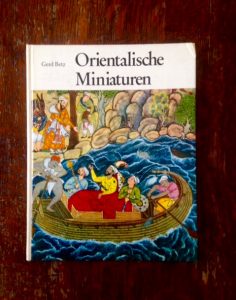I found this book at my friend’s home in Vienna; I’m sharing it with some excitement because I see so many parallels here between chefs and artists. I don’t speak German, but I can guess that on the cover is a miniature depicting Akbar, the great Mughal emperor who ruled nearly all of 16th century India.
You can’t make out the finer details here, but you can tell that the whole miniature revolves around him, as he is seated on a boat in the centre of the painting. True to the artistic tradition, every other figure is shown paying reverence to him, no matter what actions they perform.
This is the principle of hierarchy at play – even if you know nothing of his history, you, the viewer will have no doubt as to his importance. You do this everyday on your plates. You assign most importance to the the main component or centrepiece of your meal, and everything else you add just serves to ‘big it up’.
This miniature was probably taken out of one of the many manuscripts Akbar commissioned. In fact, he had entire workshops called kitabkhanas, overflowing with talent set up to produce them. There was a clear hierarchy in who did what. While the juniors laid out most of the groundwork, only the most accomplished artists were allowed to illustrate the important parts and the finer details. Can you see how they functioned much like the professional kitchens you belong to today?

